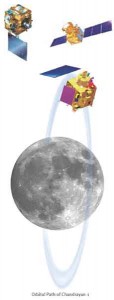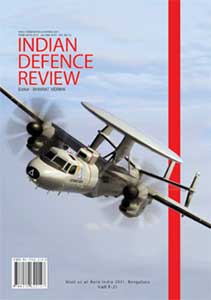To the Moon, Mars and Beyond
India’s first Moon mission, Chandrayaan-1, was launched aboard PSLV-C11 on October 22, 2008. The sturdy PSLV used larger strap-on motors to lift the heavier payload that included instruments payloads from several countries. Chandrayaan-1 studied the Moon at close quarters and ultimately delivered the Indian tricolour to its surface. It was instrumental in revealing that the Moon contained significant amounts of water. This was probably the most important lunar mission by any country after the last Apollo mission of the 1970s. It was an outstanding success, even though the spacecraft lost communication with earth within a year of launch.
 Chandrayaan-2, a much heavier and more capable craft, is next. It will have an Orbiter and Lander-Rover module. ISRO will be responsible for the Orbiter and Rover while Russia’s Roskosmos will be responsible for the Lander. The goals of the mission are to improve the understanding of the origin and evolution of the Moon as well as to analyse lunar samples. It was initially planned to be launched by the advanced GSLV Mk-III. However, ISRO has decided that this launcher may not be available by 2014 and is expected to settle for a GSLV Mk-II, always assuming the latter safely executes its next mission. The Mk-II, however, carries a lighter payload, and necessary weight reduction and other modifications are likely to delay the prestigious project by at least six months. Therefore, 2014 is the earliest realistic launch date. Before that, two other specialised satellite launches are planned: Astrosat, India’s first dedicated astronomy satellite is scheduled to be ready by 2012 and work on Aditya-1, a spacecraft designed to study the Sun, is planned for completion by 2013. ISRO is also looking forward to an unmanned mission to Mars perhaps 20 years from now.
Chandrayaan-2, a much heavier and more capable craft, is next. It will have an Orbiter and Lander-Rover module. ISRO will be responsible for the Orbiter and Rover while Russia’s Roskosmos will be responsible for the Lander. The goals of the mission are to improve the understanding of the origin and evolution of the Moon as well as to analyse lunar samples. It was initially planned to be launched by the advanced GSLV Mk-III. However, ISRO has decided that this launcher may not be available by 2014 and is expected to settle for a GSLV Mk-II, always assuming the latter safely executes its next mission. The Mk-II, however, carries a lighter payload, and necessary weight reduction and other modifications are likely to delay the prestigious project by at least six months. Therefore, 2014 is the earliest realistic launch date. Before that, two other specialised satellite launches are planned: Astrosat, India’s first dedicated astronomy satellite is scheduled to be ready by 2012 and work on Aditya-1, a spacecraft designed to study the Sun, is planned for completion by 2013. ISRO is also looking forward to an unmanned mission to Mars perhaps 20 years from now.
But the most exciting project, by far, is the human spaceflight mission. On June 01, 2011, former president APJ Abdul Kalam said, “I believe an Indian astronaut will walk on the Moon in 2025 and on Mars by 2035.” In 2008, ISRO announced plans for a human space capsule and initiated pre-project activities to study technical, safety and managerial issues related to the mission. The capsule is a blunt, conical spacecraft with a cylindrical service module, designed to carry two or three astronauts. The GSLV Mk-III will launch the orbital vehicle with the astronauts on board to about 300 km LEO and the capsule will be recovered subsequently. Much later there may be a manned mission to the Moon, for which necessary technologies and human safety features are being developed. First, however, will be the critical process of achieving “man rating” or certifying the launch vehicle as fit to carry astronauts. Essential to the process is building up a high degree of technological reliability, demonstrated over several successful test flights. Additional safety features like an escape system for the crew will need to be incorporated. Rates of acceleration, sound and vibration levels will all need to be within the limit of human tolerance. Unless man rating of the GSLV is achieved, ISRO cannot proceed with its first human spaceflight mission.
Can ISRO Do It?
ISRO’s USP thus far has been its ability to launch sophisticated satellites cheaply and reliably, courtesy the PSLV. All Indian remote sensing satellites are now launched domestically. This is also achievable for communications satellites if the GSLV becomes as reliable as the PSLV and the next-generation GSLV Mk-III is rendered operational. Through its commercial arm, Antrix Corporation, ISRO has received orders from Canada, Indonesia, Germany and other countries to launch a dozen satellites in sun-synchronous orbits over the next two years. However, the profitability of satellite launches is currently rather low because of the high cost of rocket fuel and one-time usage of rockets. Therefore, ISRO is working on a project to develop reusable satellite launchers by 2030, which would greatly reduce launch costs.
“¦time is running out for ISRO, since 2016 looms large as the target for the launch of the first Indian human spaceflight. To meet it, the space agency will need to expeditiously bring the GSLV back on track.
But the elephant in the room is the uncertain progress of the GSLV. Practically every important forthcoming Indian space endeavour depends on this temperamental launch vehicle. The Russian space agency that provided cryogenic engines earlier has ceased production and may not be able to supply any more. This leaves ISRO with two options: either to continue to develop indigenous cryogenic technology or to enlist outside support for launching medium and heavy payloads. It has also been suggested that India’s cherished human spaceflight goal could be met by a suborbital flight to begin with—like the USSR and USA did in the early 1960s. Could the PSLV, with some refinements, be adapted to launch a single astronaut in a small space capsule on a suborbital flight? It would give ISRO more time to prove the reliability of the GSLV before mounting human orbital flights.
As of now, ISRO is forging ahead with the GSLV Mk-II. The next flight of this rocket fitted with an indigenous cryogenic engine is expected in 2012. After last year’s two heartbreaking failures, this launch will be a trial by fire. Further in the future, the GSLV Mk-III is expected to make India fully self-reliant in launching heavy satellites weighing 4500 to 5000 kg. It will also enhance the country’s claims to be a competitive player in the multimillion dollar commercial launch market and boost its human spaceflight hopes. Its first flight is expected within two years.
 But time is running out for ISRO, since 2016 looms large as the target for the launch of the first Indian human spaceflight. To meet it, the space agency will need to expeditiously bring the GSLV back on track. It must launch GSLV Mk-II and later Mk-III missions at the rate of at least four per year. And it cannot afford more than two or three failures over the next few years. Only time will tell if it is equal to the challenge.
But time is running out for ISRO, since 2016 looms large as the target for the launch of the first Indian human spaceflight. To meet it, the space agency will need to expeditiously bring the GSLV back on track. It must launch GSLV Mk-II and later Mk-III missions at the rate of at least four per year. And it cannot afford more than two or three failures over the next few years. Only time will tell if it is equal to the challenge.




